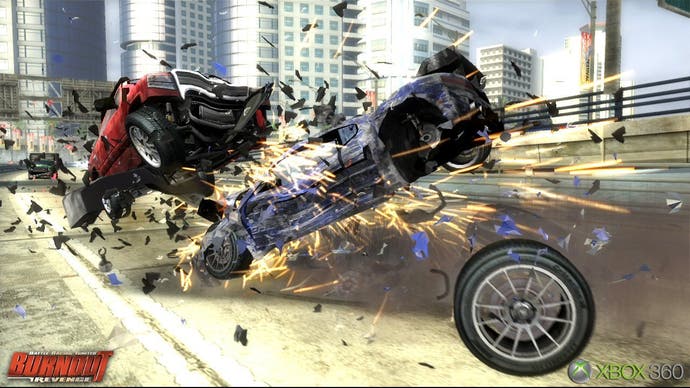Burnout: Revenge
Sweeter than ever.
When it came out last September on the Xbox, we can't deny our initial reaction to Burnout Revenge was one of slightly muted disappointment, and looking back it's easy to see why. This beloved series has become one of our all-time favourites, so to see Criterion shamelessly pandering to the mainstream left us with a feeling of resigned disappointment. It was - in the main - way too easy to blitz through the game, the new traffic checking system felt like one idea too many, and the online implementation was still not quite there.
So, as pointless as porting the game to the 360 appeared, it at least gave Criterion a chance to tweak a few elements of the package, buff up the visuals, and deliver a much better online game where you can now exact revenge on friends and enemies. Whether it's worth paying almost double for what amount to minor improvements is a moot point, but we'll try and leave the pricing squabbles out of this discussion for the sake of argument.
If you haven't played the Xbox version, then effectively what you're in for is some of Criterion's best work to date, alongside ideas that you'll either love, hate, or warm to eventually. As ever, the game lives up to its billing as the fastest and most destructive racing game out there, offering a brilliant mixture of racing challenges, time trials, and crash junctions.
Rival school

In the standard-issue camp, Criterion dishes up plenty of regular first-past-the-post racing against five AI opponents, as well as Eliminator races, where the last placed car gets taken out every 30 seconds, and Burning Lap (against the clock) to keep the traditionalists happy. Beyond that, there's the all-new Traffic Attack, where the idea is to shunt same-way traffic out of the way to cause as much damage as possible while topping up your time meter; Road Rage, the bash-your-rivals-to-gain-time-and-medals mode; as well as 50 Crash events - ten more than the original PS2/Xbox version, but still 50 less than Burnout 3 featured, remember.
The big, controversial difference between Burnout 3 and Burnout Revenge was the new ability to gain boost from 'Traffic Checking', or blatting anything from behind smaller than a bus. Not only can you use it to top up your boost bar, but turn the road into a giant moving snooker table where you can casually set up explosive trick shots to potentially take down rivals in new and exciting ways.
At first, Traffic Checking seems like an irksome new addition to the series that makes it nearly impossible not to boost your way around every event. If you're not gaining boost from Checking, you're gaining it from driving into oncoming traffic, gaining air, drifting, takedowns... basically anything that doesn't involve crashing into oncoming traffic or an immovable obstacle. Even then, crashing gives you a chance to use aftertouch to steer your way into rivals after the fact and - you guessed it - gain more boost. Boost boost boost. It seemed like one of those needless features bolted onto a nigh-on perfect game, and one that turns the game into something a lot of us weren't 100 per cent charmed by, because boosting now felt obligatory rather than a special reward, and that in itself felt wrong.
Half and half

Part of the issue here is just how easy the first half of the game is. Criterion seemed to be under the impression that it needed to make most of the game so ridiculously simple that all you had to do was press one button, vaguely steer in a straight line and win a medal. And with so much of the game unlockable by winning nothing more than the ludicrously straightforward Bronze medals, you have to play for absolutely hours on end to meet anything approaching a true challenge.
In Criterion's defence, it felt the need to make the game more accessible to the masses - and it does - but on the other hand, it singularly manages to alienate the core audience that hold it dear to their hearts. Fortunately for the long-term fans of the series, the real meat of the game is in there - you just have to wait a while for it to appear. Cleverly, Criterion makes the already massively improved World Tour progression structure even better by reserving the Gamerscore Achievement points for those people willing to go all the way and complete each tier on Perfect - no mean feat. With this carrot dangling above you, there's far more incentive to replay each and every event until you've extracted all five stars from each, and with that in mind the true challenge within some of the events really comes to the fore.
The progression structure's a clever sod, too, because it allows fans of specific types of race events (i.e. Crash, in our case) to go through much of the game playing these events exclusively. Eventually, of course, you find yourself lacking enough points to make it to the next tier, but on the whole the game does a great job of allowing you to play things in your own order, rather than prescribing a route.


